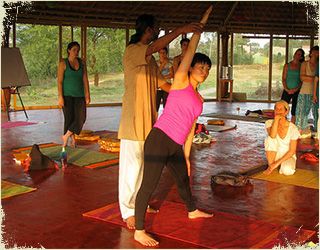 Ashtanga is a Sanskrit word which is a combination of two different words ‘Ashta’ and ‘Anga’. ‘Ashta’ means the number 8 and ‘Anga’ means limbs. So, the literal meaning of Ashtanga is Eight-limbed yoga.
Ashtanga is a Sanskrit word which is a combination of two different words ‘Ashta’ and ‘Anga’. ‘Ashta’ means the number 8 and ‘Anga’ means limbs. So, the literal meaning of Ashtanga is Eight-limbed yoga.
“Samskara saksat karanat purvajati jnanam. Through sustained focus and meditation on our patterns, habits, and conditioning, we gain knowledge and understanding of our past and how we can change the patterns that aren’t serving us to live more freely and fully.” Yoga Sutra III.18
When we talk about ashtanga yoga, which many people practice in India, it is essentially yoga practice based on the Patanjali philosophy. There are many ashtanga yoga teacher training institutions in India, however it is important to understand what Ashtanga yoga really means before undergoing any training course for ashtanga yoga in india. As per this philosophy, the path of internal purification that reveals the universal self, is essentially made up of the following 8 spiritual practices.
The Eight limbs of Ashtanga yoga
Yama (moral codes)
Satya – Truthfulness
Ahimsa – Non-violence
Brahmacharya – Celibacy or continence
Asteya – Non-stealing
Aparigah – Non-possessiveness or non-hoarding
Niyama (study and self-purification)
Santosh – Contentment
Eswar Pranidhan – Dedication
Tapa – Endurance
Shouucha – Purity
Swadhyaya – Self-study
Asana (yoga postures)
A comfortable and stable posture that helps you achieve mental equilibrium.
Pranayama (breath control)
Extension and breath control
Pratyahara (sense control)
Preparation of the mind to increase its power
Dharana (concentration)
Concentrating on one single object as well as its field
Dhyana (meditation)
The withdrawal of mine from all the external objects, thereafter focusing it on one single point, and then meditating on that point.
Samadhi (salvation or merging with the pure existence)
A state of experiencing super joy and bliss wherein the individual consciousness merges with the universal consciousness. It’s a union of the paramatman and jivatman. Union between Shiva and the Shakti in the Sahasrar Chakra (the area on top of the head). Realisation of consciousness or the realisation that God is the final achievement of the human birth.
The above-specified 8 branches support each other mutually and are meant to be learnt and practiced on a daily basis.
An established yoga practice helps people/yogis to prepare for a balanced practice of the subtle limbs, like pranayama, which are important for embodying niyamas and yamas. Essentially, it teaches that the heart of the yoga is compassion, honesty and ethical living. And those are the exactly same values that experts at AyurYoga Eco-Ashram India actively practice, and help others imbibe in their day-to-day lives. You can learn more about yoga teacher training courses offered by AyurYoga Eco Ashram by clicking here.

